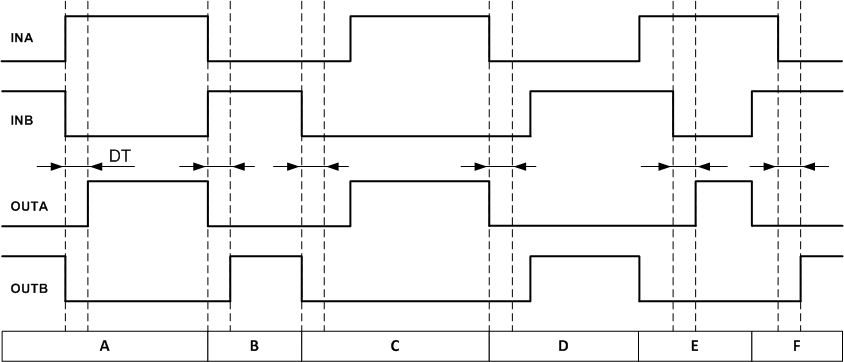JAJSG66E September 2018 – November 2024 UCC21540 , UCC21540A , UCC21541 , UCC21542
PRODUCTION DATA
- 1
- 1 特長
- 2 アプリケーション
- 3 概要
- 4 デバイス比較表
- 5 ピン構成および機能
- 6 仕様
- 7 パラメータ測定情報
- 8 詳細説明
-
9 アプリケーションと実装
- 9.1 アプリケーション情報
- 9.2 代表的なアプリケーション
- 10電源に関する推奨事項
- 11レイアウト
- 12デバイスおよびドキュメントのサポート
- 13改訂履歴
- 14メカニカル、パッケージ、および注文情報
パッケージ・オプション
デバイスごとのパッケージ図は、PDF版データシートをご参照ください。
メカニカル・データ(パッケージ|ピン)
- DWK|14
- DW|16
サーマルパッド・メカニカル・データ
- DW|16
発注情報
8.4.2.2 DT ピンと GND ピンの間に設定抵抗を接続
DT ピンと GND の間に抵抗 RDT を配置することで、tDT を設定します。ノイズ耐性を向上させるため、DT ピンに近接して配置した 1nF 以下のセラミック コンデンサでこのピンをバイパスすることを推奨します。適切な RDT 値は以下のように求められます。

ここで、
- tDT は設定されるデッド タイム (ns) です。
- RDT は DT ピンと GND の間の抵抗の値 (kΩ) です。
RDT はこのピンに小さな電流を設定し、それによってデッド タイムが設定されます。RDT の値が増加するにつれて、DT ピンから流れ出す電流は減少します。RDT = 100kΩ の場合、DT ピンの電流は 10µA 未満です。より大きい RDT 値を使う場合、ノイズ耐性を高めかつ両チャネル間のデッド タイム マッチングを向上させるため、DT ピンにできるだけ近づけて RDT とセラミック コンデンサ (1nF 以下) を配置することを推奨します。
片方の入力信号の立ち下がりエッジにより、他方の信号の設定済みデッド タイムが開始されます。設定済みデッド タイムとは、ドライバが両方の出力を強制的に LOW に保持する最小期間です。設定された最小値よりも長いデッド タイムが INA および INB 信号に含まれる場合、出力は設定済みデッド タイムよりも長い間 LOW に保持されることがあります。両方の入力が同時に High になった場合、両方の出力は即座に Low に設定されます。この機能は、ハーフブリッジ アプリケーションでの貫通電流を防止するために使用され、通常動作時は設定済みデッド タイムの影響を受けません。ドライバのデッド タイム ロジックのさまざまな動作条件を以下に示し、説明します。
 図 8-4 入力信号と入出力ロジックの関係
図 8-4 入力信号と入出力ロジックの関係条件 A:INB が Low、INA が High に遷移します。INB は即座に OUTB を LOW に設定し、設定済みデッド タイムが OUTA に割り当てられます。設定済みデッド タイムの後、OUTA は HIGH に遷移できます。
条件 B:INB が High、INA が Low に遷移します。今度は INA は即座に OUTA を LOW に設定し、設定済みデッド タイムが OUTB に割り当てられます。設定済みデッド タイムの後、OUTB は HIGH に遷移できます。
条件 C:INB が Low になりますが、INA はまだ Low のままです。INB は即座に OUTB を LOW に設定し、設定済みデッド タイムが OUTA に割り当てられます。この例では、入力信号のデッド タイムは設定済みデッド タイムよりも長くなっています。入力信号のデッド タイムが経過した後、INA が HIGH に遷移すると、OUTA は即座に HIGH に設定されます。
条件 D:INA が Low になりますが、INB はまだ Low のままです。INA は即座に OUTA を LOW に設定し、設定済みデッド タイムが OUTB に割り当てられます。この例では、入力信号のデッド タイムは設定済みデッド タイムよりも長くなっています。入力信号のデッド タイムが経過した後、INB が HIGH に遷移すると、OUTB は即座に HIGH に設定されます。
条件 E:INB と OUTB がまだ High のうちに、INA が High に遷移します。オーバーシュートを防止するため、OUTB は即座に LOW に駆動されます。その後 OUTB は LOW に遷移し、設定済みデッド タイムが OUTA に割り当てられます。OUTB はすでに Low になっているため、設定済みデッド タイムの後、OUTA は HIGH に遷移できます。
条件 F:INA と OUTA がまだ High のうちに、INB が High に遷移します。オーバーシュートを防止するため、OUTA は即座に LOW に駆動されます。その後 OUTA は LOW に遷移し、設定済みデッド タイムが OUTB に割り当てられます。OUTA はすでに Low になっているため、設定済みデッド タイムの後、OUTB は HIGH に遷移できます。